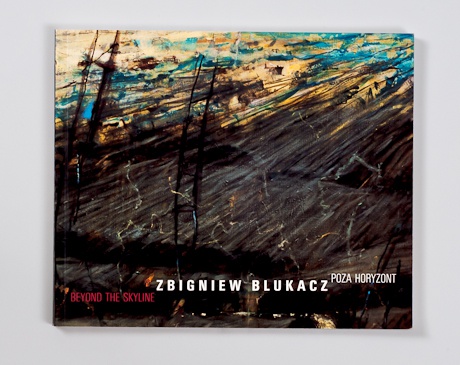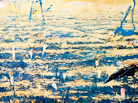katalog „Zbigniew Blukacz — poza horyzont”

rok wydania: 2004
format: 24 × 29 cm
objętość: 104 strony
oprawa: miękka
reprodukcje kolorowe
j. polski/angielski
projekt graficzny i skład: Krzysztof Morcinek
wydawca: Galeria Sztuki Współczesnej BWA w Katowicach
ISBN 83-88254-27-8
Spis treści:
Jerzy Madeyski
Ireneusz Walczak „Jest obraz choć świat się zmienia”
Prace
Biografia
Cena: 11 zł
Zapraszamy do księgarni!
Zamów książkę: ksiegarnia@bwa.katowice.pl

Zbigniew Blukacz — Poza horyzont (malarstwo) (…) Blukacz schodzi z nieba na ziemię i zaczyna malować pejzaże. I nic ponadto. Zawęża więc drastycznie motyw. Jest wobec siebie bardziej...

„Sytuację egzystencjalną współczesnych twórców świetnie ujął reżyser Krystian Lupa: ‘Świat przestał być dla człowieka przytulnym gniazdem. Młodzi ludzie stoją wobec rzeczywistości, która ich przerasta spotworniałej i obcej, a takie są teraz doświadczenia młodych twórców szukających nowego wyrazu’.
Zbigniew Blukacz konsekwentnie nie zmierza w rejony modnej tematyki, lecz chce zawrócić czas i nie jest to rodzaj kapitulacji w postaci powrotu do bardziej tradycyjnego obrazowania. Jest to swoista kronika przeżyć, dokumentująca próby odnalezienia jedności z naturą i swojego miejsca w jej rytmie. Dzieje się to w świecie wzniosłych uczuć oderwanych od aktualności publicystycznej. Zbyszek wcześnie stworzył własny system poglądów i nie musi się przestrajać w zależności od panującej mody.
W zasadzie reprezentuje styl bardzo kameralny i tworzony jedynie przez Zbigniewa Blukacza, nie kierujący się modami, ani koniunkturą. Proponuje własne spojrzenie na przestrzeń, oglądając jego obrazy mamy wrażenie niecodziennej wędrówki po rozmaitych odsłonach pejzażu. Odchodzi w naturę do mistycznej krainy wolności, szczęścia i medytacji. Jego interpretacja pejzażu jest głęboko przemyślana, pokazuje nowe rozumienie czasu, operuje niuansem, subtelnością i szeptem. Jest to ucieczka w krainę spokoju, oczyszczenia, dobra, odpoczynku i refleksji. Jego sztuka inspiruje, wzbogaca duchowo i ma w sobie jakąś tajemnicę. Wiele miejsca w jego malarstwie zajmują formy ostrych skał, wodospadów, dzikiej przyrody, kałuż, drogi i pól aż po horyzont, słońca przedzierającego się przez szczeliny drzew i plątaniny krzewów. Wprowadza nas w kręty, migotliwy labirynt wspomnień, pamięci, wyobraźni, uczuć, również codzienności i faktów, które zdarzyły się dawno i współżyją z tym co dzieje się obecnie. Na jego płótnach powstaje zaskakujący dialog między namiętnością, a chłodną obserwacją i grą optyczną. Świat tych obrazów stworzony jest prostymi środkami: koloru, światła, faktury. Płaszczyzny jaśnieją i ciemnieją na przemian. Zwłaszcza niesamowicie używa światła, które krąży, pulsuje i wydobywa to, co najważniejsze. Jest to rodzaj narracji pozornie realistyczny, w którym przetwarzanie natury zmierza w stronę abstrakcji organicznej. W dużej części te obrazy są transpozycją natury uwolnionej od jakiejkolwiek określonej formy, tworzą magiczny kosmos mieniący się świetlistymi barwami. Zbyszek jest dla mnie jednym z nielicznych, który posiada kod dostępu do tego świata. Jestem również przekonany, że jest to talent, który odnalazłby się w każdej epoce.
Duże formaty w znacznym stopniu warunkują sposób odbioru i oglądania płócien. Z jednej strony wymuszają dystans fizyczny, a z drugiej czasowy, potrzebny do ogarnięcia całości. W pewnym momencie pozwalają wejść odbiorcy w głąb przestrzeni na obrazie, który w sposób metaforyczny i dosłowny jest ekranem otwierającym się na odmienną rzeczywistość.
Jest to świat autonomiczny, ale też otwarty, zmienny i świadomy swej tradycji. Zbyszek czasami każe nam myśleć o swoich pejzażach w sposób nostalgiczny, sentymentalny, przywołując widoki z przeszłości. Jego wspomnienia bywają radosne, troszczy się o nie, wielokrotnie idealizuje powroty do swego dzieciństwa, rodziny, a nawet ostatnich wakacji, a dzikie ogrody traktuje jak część domu,jak wnętrze pełne intymnych zakamarków. Uświadamia nam, że potrzebujemy czułości, że świat nie jest doskonały, że piękno istnieje, a my potrzebujemy piękna, bo bez niego życie nie ma smaku. W jego obrazach możemy poczuć, że życie nie jest po nic. I jest to ciągle afirmacja życia, z którego jeszcze dekalog nie został wymazany.
Postawa Zbyszka również symbolizuje powrót do czasów, gdy miłość między malarzem, a jego obrazem była żywa. W tej postawie nie ma cynizmu, emanuje tylko pasja — jego sztuka jest nie sztuczna.
W malarstwie Zbyszka warstwa pikturalna jest równie ważna jak znaczeniowa. Proszę się zastanowić nad tymi wieloma cyklami. Jak dużo się kryje tajemnic w ‘Zakamarkach’, jaką piękną ucieczką w świat miniony jest ‘Czas huśtawek’, jaki eskapizm przemawia z obrazów ‘Odyseja’, ‘Wodospady’, ‘Irlandia’, ‘Jak ptaki’, czy tych wszystkich tajemniczych ogrodów od świetlistych przestrzeni po kolory jesieni.
I tak wyliczać można długo, aż po ostatni cykl związany z drogą. To coś więcej niż tylko pejzaż z szynami kolejowymi. To otwarta przestrzeń — to nieskończoność. Ta droga linii kolejowej zachęca do refleksji nad uciekającym czasem. Mamy do pokonania jakąś przestrzeń, te linie wytyczają nam szlak. Czy zdążymy wykonać pewne rzeczy? A może nie zdążyliśmy na ten pociąg? A może jednak nadjedzie i zabierze nas w nieznane, nowe, lepsze miejsce?
I tak ciągle Zbyszek pokazuje nam obrazy, przy których słowa staja się za małe, więc nie trzeba trwać tylko przy rozumieniu — trzeba odczuwać!
I jeszcze jedno. Obserwując to, co nadchodzi w nowej sztuce Zbyszek uparcie chce nam przekazać wiarę w wizerunek świata na płótnie. Od takiej wystawy zależy istnienie świata obrazów. Myślę, że to wystawa, która doprowadzi do odbudowy nadszarpniętej ufności do malarstwa i przezwycięży kryzys obrazu. Szczerze wierzę w jego sztalugową wizję świata”.
Ireneusz Walczak
(„Jest obraz choć świat się zmienia”)




